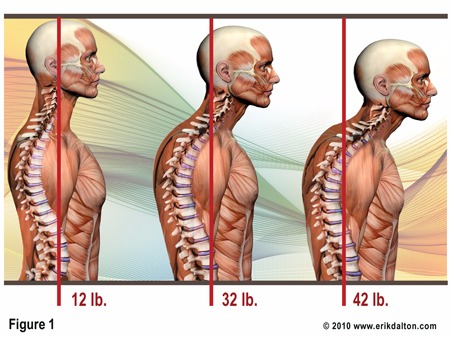
Registered Massage Therapist
Your neck is a very complex structure that consists of 7 bones, joints, muscles, ligaments, blood vessels and nerves. Your neck is capable of holding your head up, which weighs on average of 10-12 pounds.
As we age, we build strength, as well as, tension in our bodies. As a new born baby, we have very weak neck muscles and require our head to be supported at all times. Within 4 to 6 months, we start to build strength in our neck muscles and start to raise our head and hold it steady. Through time and our activities of daily living, we slowly build tension in our body, leading to pain and tension overtime. Tension builds up over many years of repetitive actions and although you may not notice it right away, it is there. Neck pain is one of the most common problems I treat everyday as a massage therapist.
Here are 5 common reasons you may be experiencing neck pain.
1.Your posture is putting strain on your neck muscles, making these muscles work harder than they should.
What happens: In a neutral spine, your head will place 10-12 lbs of force on your neck. The more forward your head is, in other words, the higher the degree the cervical spine is flexed forward, the higher the force will be on these muscles and joints.

So if your head is slouched forward, whether you are on your desk working on your computer, or looking down on your phone, you are adding more “weight” to your neck muscles and joints, causing neck pain over time.
How do I fix it: If you find yourself slouching forward, bring your head back. Strengthen your neck muscles by doing chin tucks, which consist of make a double chin, and holding it for 20 seconds for 3 times. This strengthens the deep inner muscles at the front of your neck. To strengthen the back of your neck muscles, clasp your hands and put it behind your head. Push your head back against your hand and resist. You should hold this position for 20 seconds for 3 times.
Posture will take time to adjust, be persistent with the exercises and you will slowly notice a difference.
2. Sleeping on your stomach, which requires you to turn your head to one side for many hours can cause tight neck muscles when you wake.
What happens: If you are a stomach sleeper, you may be experiencing some neck tension when you wake up. By sleeping on your stomach, your head is turned to one side for a period of time. This puts strain on your neck muscles on one side and stretches the neck muscles on the other side. But don’t get confused that all stretches are good. When you put your neck in a stretched position for a long period of time, your neck muscles will get tight and can cause pain and can lead to a neck kink, or a muscle strain, causing neck pain in the morning and the restricted range of motion.
How do I fix it: The easy solution is to not sleep on your stomach, of course its easier said than done. If you find yourself constantly turning over to your stomach when you sleep, one way to prevent this is to take a tennis ball and tape it to your chest before you go to bed. Try sleeping on your side or on our back. If you happen to turn onto your stomach over night, the tennis ball that is taped to your chest will make it uncomfortable enough for you to change positions and prevent you from staying facing down.
Give it a try and let me know how it works for you!
3. The daily stresses of life and work can build neck tension.
What happens: With the amount of hours we spend at work, in front of computer screens and deadlines to meet, we often feel tightness in our neck and shoulders. As we work, we may find our shoulders slowly creeping up to our ears as the day goes by. This causes tension in your shoulders and neck because you are putting those muscles in a constant contracted state. By the end of the night, you feel tired and heavy and ready to go home and relax and maybe even book a massage to decrease your neck tension.
How do I fix it: Taking a break and stretching your neck are a few common things we do to try to alleviate the tension. Here are a few neck stretches you can try.
- Ear to shoulder. Bend your head to the side (lateral flexion) while keeping your shoulders square. You can go into a deeper stretch by taking your hand on the same side your head to leaning towards and pull it closer to your shoulder, while depressing the opposite shoulder.
- Chin to chest. Flex your head forward and bring your chin to your chest. Feel the stretch at the back of your neck? Hold it here for 30 seconds.
- Smell your armpit. Point your nose to the direction of your armpit. You should feel a stretch at the back of your neck on the opposite side from where you are looking. For a deeper stretch, use the hand on the same side and pull from the back of your skull, downwards, increasing the stretch. Hold for 30 seconds, and repeat on the other side.
- Neck rolls. Slowly roll your head doing a circle motion from one side to the next. Try to maximize the entire range as you do this. Go 5 times on one side and 5 times the other side.
4. Neck strain or whiplash from injury/trauma due to force.
What happens: When a fast force hits you, your head will lead in the direction the force is going towards. Your neck muscles will be stretched when the force hits you, then contracts and seize up. This will cause neck pain and decrease range of motion in your neck. Whiplash is very common and can happen from your daily activities and sports that you participate in.
How do I fix it: When you have a whiplash, it will take time for your muscles to heal. Ice your neck to reduce pain and swelling for the first 1-3 days. After 3 days, switch to applying deep heat to the area. It is best to put on a neck brace to support your head and neck to prevent further injuries. For whiplash, it is best to see a massage therapist, physiotherapist or your chiropractor for professional treatment.
5. Wear and tear of your cervical discs causing Degenerative Disc Disease which leads to neck pain.
What happens: Our neck is made of 7 vertebrates and between each vertebrae, there is a jelly-like disc that acts as a cushion to allow for smooth movement of the head. Over time, these discs get worn out and provides less cushion for movement, thus contributing to a stiff neck. Research shows that 25% of people are asymptomatic under the age of 40. As this progresses, it leads to neck tension towards the end of the day and in more severe cases, nerves can be compressed, causing numbness or weakness radiating down the shoulder, arm or hand.
How do I fix it: Good news is that with degenerative disc disease, you don’t need surgery to fix it. A massage therapist, physiotherapist or a chiropractor can help manually manipulate the area to increase the space between the joints and decrease the pain. A physiotherapist can prescribe strengthening exercises and help improve your posture to help with your neck pain.
Next time you feel tension in your neck, pay attention to what you do that aggravates it. Try changing chances are, its been building up for a long time and has gotten to a point where you finally noticed it.
References:
- https://www.webmd.com/pain-management/features/neck-pain#2
- https://www.webmd.com/pain-management/features/neck-pain#1
- https://www.babycenter.com/0_baby-milestones-head-control_6579.bc
- https://www.spineuniverse.com/conditions/neck-pain
Written By:

Cassandra Kong is a massage therapist at Yonge and Eglinton who enjoys providing deep tissue massage to help relieve back and neck pain in patients.
View Profile


